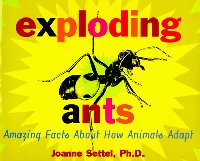|
________________
CM . . . .
Volume VI Number 18 . . . . May 12, 2000
excerpt: That slimy black-and-white lump that looks like a bird dropping may actually be alive! It could really be a swallowtail butterfly larva, a caterpillar that copies or mimics the colors and shape of a dropping to avoid getting eaten by predators. To make its disguise more realistic, the caterpillar also holds its body in the shape of a dropping and rests motionlessly on a leaf.Settel, a professor of biology at Baltimore City Community College, has put together a most enticing and informative collection of facts concerning some of the various adaptations utilized by insects and animals for survival. Organized into seven sections with such captivating and intriguing titles as "Invasion of the Body Snatchers" and "Dog Mucous and Other Tasty Treats," each section contains from two to four examples of behaviors which illustrate the theme encompassed by the section's title. Therefore, "Sucking Blood" deals with ticks, head lice, vampire bats and lampreys while "Swelling, Expanding and Exploding Bodies" looks at how some worker ants in honey ant nests serve as living storage units for honey while a different species of ant, when attacked, actually mixes chemicals within its own body which then cause the ant to explode, the resulting chemical then killing the invading insects. This section concludes by describing how the male frigate bird inflates a red throat pouch to attract females during mating season. Usually, each page deals with a single example of an adaptation. The hook is one or more colour illustrations, usually photographs, which visually show the adaptation "in action." Accompanying the illustration is a single sentence caption printed in red. Wanting to know more, the reader can then turn to the page or so of text in black ink which describes in more detail how the adaptation contributes to creature's survival. Consequently, a photo of a big pink fish, showing a much smaller pink fish seemingly biting the larger fish, has a caption which reads: "A tiny male anglerfish can be seen attached to the tail end of his female mate." Wanting to know why or how this happening occurs, the reader can turn to the longer text and discover that the male angler fish attaches itself to a female soon after it hatches and becomes, in effect, a parasite, nourished by the female's blood. "Because he no longer needs them, his eyes and digestive tract break down or degenerate....The male anglerfish doesn't need to look attractive to a female. He finds his mate and latches on. Then he has only one job: to produce sperm." At the book's conclusion, a "Glossary" defines those words which were printed in italics in the text while 13 "Selected Readings" appear to be more teacher/parent than child oriented in their content. Kids who love to collect facts, especially the unusual and the gross, will relish the juicy contents of Exploding Ants. Highly Recommended. Dave Jenkinson teaches courses in children's and adolescent literature in the Faculty of Education, the University of Manitoba.
To comment on this title or this review, send mail to cm@umanitoba.ca.
Copyright © the Manitoba Library Association.
Reproduction for personal use is permitted only if this copyright notice
is maintained. Any other reproduction is prohibited without
permission.
Published by
TABLE OF CONTENTS FOR THIS ISSUE - May 12, 2000.
AUTHORS |
TITLES |
MEDIA REVIEWS |
PROFILES |
BACK ISSUES |
SEARCH |
CMARCHIVE |
HOME
|
